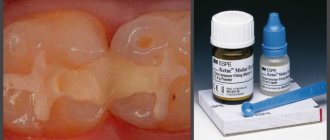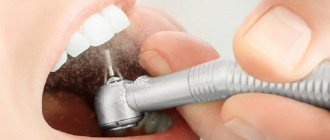Basic compulsory medical insurance program for dental fillings
The law on compulsory health insurance implies that every citizen has the right to a number of medical services, the cost of which is covered by the policy. You can get it very simply: you need to contact the insurance company with your passport, and then select a medical institution and attach it to it.
There are several types of policies. Mandatory includes a number of medical services that can be obtained in any corner of the country; optional services differ depending on the territorial region. A filling under compulsory medical insurance is placed on a person absolutely free of charge.
Optional services under the compulsory medical insurance policy include dentistry. You can get a filling not only in a public clinic, but also in a private one (provided that it is a participant in compulsory medical insurance).
The basic program includes providing the patient with emergency dental care, treatment of carious lesions in the oral cavity, removal of tartar, treatment of acute inflammatory process (pulpitis, periodontitis, etc.), jaw reduction, removal of foreign bodies from the dental cavity.
Teeth on the Shelf: How to Get a Hollywood Smile for Free
When a person clenches his jaw, each tooth experiences a force of 80 kilograms. In the test, the light filling can withstand almost twice as much. And the cement one is almost two times less than nature planned. And such fillings are stained more readily by food and drinks than others. Experts immersed the ceramics, light filling and cement in warm tea for two weeks. The ceramics were less colored. In second place is a light-curing composite, in third place is cement. All these disadvantages in many European countries have completely abandoned cement fillings.
For many, the most terrible childhood memory is still the dentist's office. Just look at the sound of the drill. But what was medieval in Soviet dentistry was not only torture, but also the materials from which dental fillings were made. But the worst thing is that even now these low-quality dental patches can be sold to us under the guise of modern technology.
The more requests, the more money the clinic receives. This means that it is beneficial for insurers that we do not get sick. And they calculated that cement fillings last an average of three months, chemical fillings last up to two years, and light fillings last at least five. And the difference in the cost of materials is more than offset by the cost of the dentist’s labor that accrues over several alterations. Therefore, it is more economical to simply pay a little less often for slightly more expensive material. This will also reduce queues in hospitals.
We recommend reading: Check Debt for Housing and Utilities Sberbank
Knowing your rights often helps you avoid problems and also unnecessary expenses. What we definitely won’t skimp on is our health. By the way, some medical institutions take advantage of this, trying to extract money from patients for what they are entitled to for free under the compulsory medical insurance policy.
What types of dental fillings can be obtained free of charge under compulsory medical insurance?
Patients are wondering what kind of filling is required under the compulsory medical insurance policy? It all depends on the insurance company and clinic with which the contract is concluded. As a rule, the patient can go to the clinic to install an ordinary photopolymer filling and use an anesthetic.
If you have a question about what fillings are placed in free clinics under compulsory medical insurance, you must contact the insurance company with which the contract has been concluded. There, experts will tell you in detail which clinics a person can go to for free help. Light fillings under compulsory medical insurance are paid additionally by the patient at his request. Typically, your dentist can suggest an alternative light filling material that will replace the cheaper option covered by your health insurance policy.
The patient can also count on the following types of free services under the insurance policy:
- preventive examination at the dentist;
- treatment of bleeding gums;
- removal of dental plaque in the traditional way (manual). If a patient wishes to undergo ultrasonic cleaning, you need to check with the clinic whether this is included in the list of free services;
- removal of tumors;
- root canal treatment, etc.
Aesthetic procedures (whitening, teeth straightening, etc.) are not always included in the list of free services under the compulsory medical insurance policy. This question can be clarified in the insurance department of the company with which the contract was signed.
Dental treatment under the compulsory medical insurance policy is free in 2020
- Production of veneers by direct and indirect methods;
- The use of intracanal pins (fiberglass, parapulp, etc.);
- Treatment of root canals of teeth: treatment of root canals using NITI rotating machine instruments, filling of root canals using gutta-percha pins and imported pastes using various filling methods;
- Intra-canal whitening of pulpless (“dead”) teeth;
- Restoration of the tooth stump under an artificial crown from modern polymer and glass ionomer materials of imported origin;
- Treatment of inflammatory periodontal diseases using modern methods (VECTOR device, laser, ultrasound therapy), using imported materials (directed tissue regeneration, splinting of mobile teeth, cosmetic closure of exposed tooth necks, etc.);
- Surgical methods for the treatment of periodontal diseases (open curettage, flap surgery, gingivoplasty, etc.);
- Implantology, operations on directed bone regeneration and plastic surgery of soft tissues in the area of implants;
- Tooth extraction for orthodontic and orthopedic indications for persons over 18 years of age
- Depulpation of teeth under X-ray control in order to prepare teeth for dentures;
- Cystotomy;
- Cystectomy (removal of the root cyst);
- Plastic surgery of the frenulum of the upper or lower lip, frenulum of the tongue for persons over 18 years of age;
- Plastic surgery of scars and cords of the oral mucosa;
- Plastic surgery for gum recession, including connective tissue graft (local tissue);
- Resection of the root apex;
- Hemisection;
- Vestibuloplasty surgery;
- Installation of implants;
- Prosthetics on implants;
- Correction of lip and tongue frenulum using a diode laser (for children and adults);
- Providing orthopedic treatment to persons over 18 years of age and of working age;
- Partial and complete removable laminar dentures made from imported material;
- Clasp dentures of varying degrees of complexity
- Fixed dentures (single and bridge dentures: steel, plastic, metal-plastic, metal-ceramic, prostheses made of gold and precious metals) from imported materials;
- Retreatment of teeth for the purpose of dental prosthetics previously treated in other health care facilities;
- Unsealing root canals for inlays for the purpose of dental prosthetics.
- Carrying out orthodontic treatment using fixed appliances, functional appliances and complex orthodontic plates made from imported materials;
- Anesthesia using carpule syringes and imported anesthetics;
- General anesthesia (anesthesia) with the use of an anesthetic aid for more than 30 minutes using imported drugs;
- Treatment and removal of teeth using sedation methods while maintaining consciousness;
- Prevention of dental diseases: professional oral hygiene, removal of dental plaque using an ultrasonic device, use of AIR-FLOW, removal of age spots, plaque, coating with imported fluoride-containing preparations, deep fluoridation of teeth, teeth whitening
- Three-dimensional computed tomography of the maxillofacial region in 3D format, orthopantomography;
- Orthopantomography of the maxillofacial area for persons over 18 years of age and of working age;
- X-ray examination when providing paid medical services and preparing for dentures
We recommend reading: Minimum Living Wage in Moscow in 2019 for a Family of 3 Persons
To provide medical care at home, a preliminary examination by a local physician is required, followed by the issuance of a report on the general state of health and the possibility of providing assistance at home. Comprehensive dental care at home for disabled people with severe disabilities is provided in accordance with the list of dental services:
Are there any benefits of compulsory medical insurance treatment for children?
Some clinics enter into agreements with insurance companies that allow free treatment of children. Thanks to the children's compulsory medical insurance policy, parents have the opportunity not only to install fillings on baby and permanent teeth, but also to cope with a number of other problems:
- correction of bite;
- teaching the child the rules of oral hygiene;
- treatment of inflammatory processes;
- coating baby teeth with special enamel, which reduces the risk of developing caries in the future.
After compulsory medical insurance does not cover services for dental surgery or installation of systems. These manipulations are paid separately.
Is a light seal included in the policy?
Patients who have encountered caries are interested in whether a light filling is included in compulsory medical insurance? Unfortunately, as of 2020, the installation of light photopolymer fillings is carried out only on a paid basis. This is due to the use of expensive material.
A public clinic can install this type of filling for a patient free of charge only for strict medical reasons (for example, cervical caries). When visiting a paid clinic, a patient may be given a light filling, but will be charged money for dental treatment. In this case, you must keep the receipt and transfer it to the insurance company for a partial refund.
Should light seals be installed free of charge according to Polusb MS Rosno
- Author), approved by the government, does not contain restrictions on the types and costs of consumables. This means: the patient must be provided with what he needs for medical reasons and based on modern standards of treatment.
How to install a light seal for free in a clinic under the compulsory medical insurance policy in 2020
A story from the program Morning of Russia. There are no free dentists; their work costs money. Dental procedures are paid for either by the patient himself or by the insurance company. If a person is treated under insurance, all medical services provided to him are financed from the regional compulsory medical insurance fund. Photopolymer light fillings are practically not placed under the compulsory medical insurance policy, which is due to their high cost and insufficient funding from insurance funds.
We recommend reading: Donation of an apartment tax
“I have been seeking an official response from the Ministry of Health on this topic for almost six months and I want to publish it through KP so that everyone knows,” said Alexey Starchenko back in the middle of last year. In addition, a number of dental procedures will have to be paid for in any case, since their implementation is not covered by compulsory health insurance.
How much does a light filling cost according to compulsory medical insurance?
According to the Law, a patient can count on the installation of a light-curing filling under the compulsory medical insurance policy free of charge, but subject to the use of domestically produced polymer materials. For foreign fillings you need to pay extra. Prices for fillings can be found in the clinic, which is included in the compulsory medical insurance policy. The warranty on the installed filling is 1 year, regardless of the material or type of clinic where the filling was performed.
The cost of a light seal starts from 800 rubles. in regular clinics. The amount can increase several times if the patient is treated in a paid dental clinic. The dentist may also offer the patient to pay additionally for anesthesia. The list of free services under the compulsory medical insurance policy includes ordinary lidocaine. If this drug is intolerant, the patient is offered an alternative anesthetic or a paid one (carpural, which requires a specific syringe).
How does a paid filling differ from a free one: types, composition, comparisons and the opinion of dentists
How does a paid seal differ from a free one? The former contain various additives and additional components that provide better polymerization. Thanks to this, the mixture is more homogeneous and has no air bubbles, and also hardens much better.
Classification of fillings
In public hospitals, people are treated for free, so when filling they use ordinary cement compounds. But in private clinics today additional components are added to their composition to increase strength and durability. Depending on the additives used, cement fillings are divided into the following types:
It is also important to understand that the list of services depends on the availability of special equipment and the necessary personnel in a particular clinic. Large dental centers provide more services than a small private office.
We recommend reading: List of Departmental Awards for Conferring the Title Veteran of Labor of the Russian Federation Since 2020 With Changes
If for medical reasons
For example, lidocaine is contraindicated for the patient; it will be replaced with another drug at no additional charge. But if there are no contraindications, but the patient still wants another drug, they will need to pay extra for it.
Dentistry and compulsory medical insurance
In both cases, you need a compulsory medical insurance policy, even when seeking emergency care. The law allows in some cases to seek emergency care without a policy, for example, if the patient forgot it at home or lost it. Then the hospital will have to send a request to the compulsory medical insurance fund and confirm the patient’s right to help.
All consumables used on an outpatient basis are free for the patient. And the fact that compulsory medical insurance uses materials of poor quality is misinformation; such materials simply cannot be included in the list of materials and medicines approved by the Ministry of Health. Therefore, for any demands to pay extra, call your insurance company for clarification and protection of rights, explains Bereznikov.
The price of a light-curing filling depends on the status and price list of the dental clinic and location. If this is a state dental institution, then according to the compulsory medical insurance policy it is necessary to pay only for the materials spent by the patient.
What is included in dental services under compulsory medical insurance?
When attached to a district clinic or clinic at a temporary place of residence, the insurance company is obliged to provide a list of medical organizations that can be freely visited and at the same time receive free care.
Free dental treatment under the usual compulsory medical insurance policy is available in public clinics and hospital departments of maxillofacial surgery. To find a medical institution where you can have your teeth treated for free, just find the nearest budget clinic.
How can you be treated for free under compulsory medical insurance?
Every patient should know that having a policy in hand, he can receive free care in any corner of the country (dentistry and maxillofacial surgery departments). This applies to cases of planned and emergency calls.
When making scheduled visits to the dentist, a person needs to make an appointment in advance, find out whether the institution provides light fillings according to compulsory medical insurance, and other questions. In case of emergency, the patient is examined within several hours.
A patient can seek emergency care free of charge at a public clinic even if he does not have a medical insurance policy. In this case, the doctor sends a request to the insurance company where the contract was concluded. If the answer is positive, then the patient undergoes all the necessary manipulations. In practice, this is rarely done, since the hospital does not want to lose its money in the event of an unauthorized procedure (when the patient does not have an insurance policy).
Is a Light Curing Filling Included in the Compulsory Medical Insurance in 2020?
Good afternoon I am a dentist, I work in a state clinic, and the question has arisen: our people want it for free and excellently. I remember hearing somewhere that there is a law or an application, I don’t remember exactly, that legally we can offer a patient at a free appointment under compulsory medical insurance a filling, for example, a light-curing one, which is in no way issued by the clinic and is not paid for from compulsory medical insurance funds with their additional payment, respectively purchased at your own expense.
The seal is sold twice
On the issue of the legality of the actions of officials, you always have the right to clarify or make an official request and receive an answer to it within the time limits established by law to the management of the clinic, the municipal health department, or the territorial department for compulsory medical insurance. This also applies to the issue of pricing. In addition, it should be understood that the current system in the Russian Federation for the provision of free medical services is regulated, in particular, by territorial admission standards for certain medical services per day, month, etc.
Poor environment, poor nutrition, insufficient consumption of natural products, deficiency of important vitamins and minerals in the body, improper oral hygiene, the presence of chronic diseases and genetic predisposition are just some of the reasons that bring a patient to the dentist’s office. At the same time, it is important for a person to receive high-quality treatment that will help eliminate pain, restore aesthetics to the smile, normalize chewing functions and restore the anatomical shape of the tooth.
This is interesting: List of property tax from cadastral value for 2020 Stavropol
How to get good fillings under the compulsory medical insurance policy
Before inserting a filling into a diseased tooth, you need to ask what materials the doctor uses. If the patient is not satisfied with the manufacturer of the polymer material, then he can refuse filling in this clinic and find a suitable option for him (for example, a private clinic that uses foreign-made materials).
In some clinics, treatment under the policy is carried out only in case of regular preventive visits to the dentist. If the patient ignores the examination schedule, the hospital may refuse free treatment. In this case, it is recommended to contact the insurance company, which will conduct an investigation and give a final answer to the patient. To avoid such situations, it is recommended to have an annual dental checkup.
Which clinics accept patients under compulsory medical insurance?
A person can receive dental care in any clinic (private or public). You can view the list of institutions at the insurance company with which the contract was signed.
You should definitely inquire about the conditions for the territorial use of the compulsory medical insurance policy. If a person often travels on business, he needs to clearly understand which medical institutions he can get help in case of an emergency.
Which is better to choose a dentistry: one that accepts compulsory medical insurance or a paid one?
It all depends on the degree of complexity of the problem for which the patient is seeking treatment. Before signing an agreement with the insurance company, you need to clarify in which clinics the services will be provided. Today there is a misconception that treatment in public dentistry is worse than in private ones. Not always like this. State-run clinics provide me with high-quality filling materials, anesthetics, etc. Also, specialists regularly take advanced training courses.
It is worth noting that some clinics can provide treatment in case of a broken filling only during the warranty period. This point must be clarified with the insurance department when receiving a compulsory medical insurance policy.









